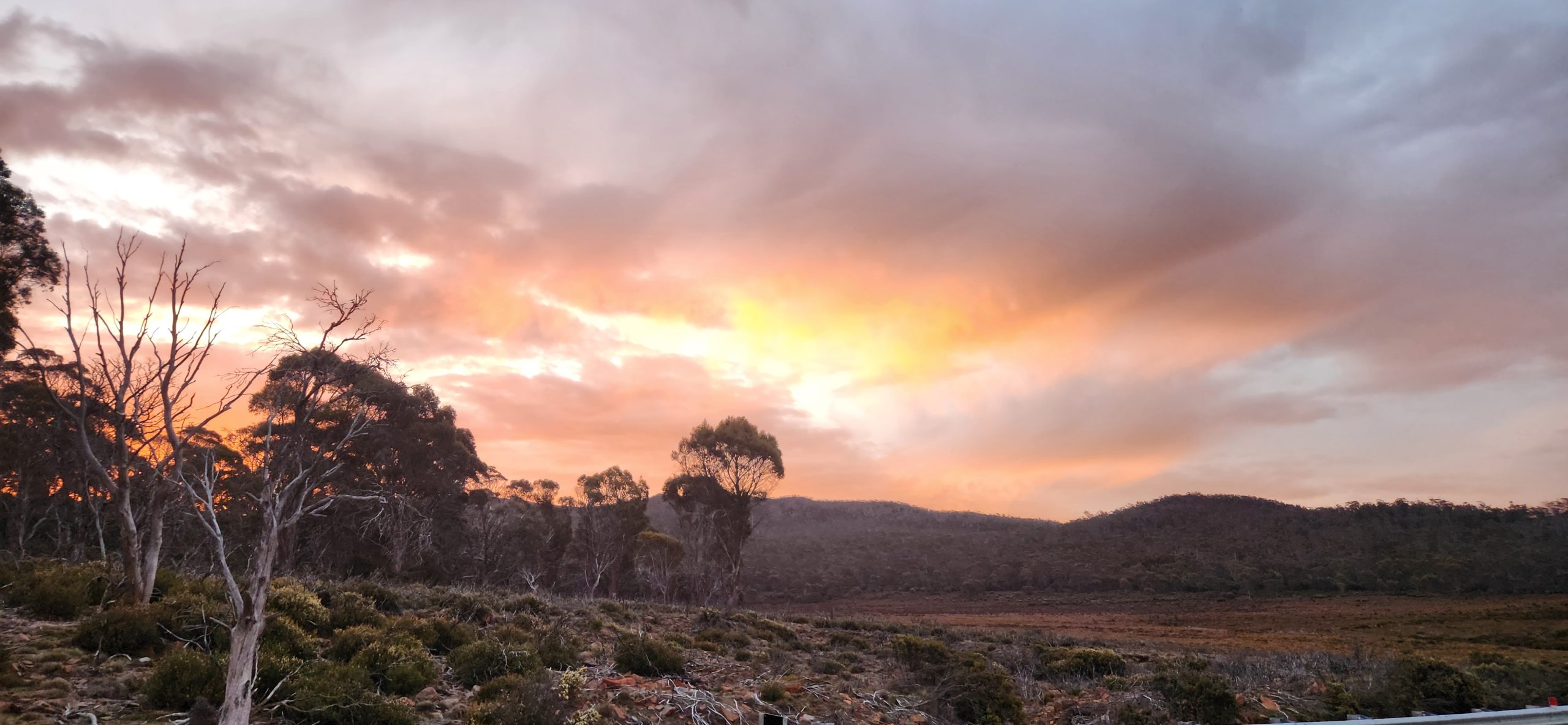
Christmas 2024 in Tasmania – Amateur hunt for the Aussie classics
Disclaimer: All of the pictures in the following report are terrible, the average shot of Bigfoot is usually clearer. Everything was taken with a phone as the only camera we have has a macro lens.
Disclaimer2: I am a bug nerd. I know this is a site about mammals so I’ve kept it mostly mammal related, but I couldn’t help myself and have written a line or two about some cool bug finds.
Although I would not self-describe as a mammal watcher, some long-lost ancestral memory (probably beaten into me as a child) resurfaced as my partner’s family mentioned how cool it would be to see all the classic Australian mammals during their short time there. It might also just have been me imagining that’s what they wanted to do, since I don’t think I know how to travel like a normal person. Either way, the following report is the result. Although we didn’t see anything particularly rare, I would call it a success – at least for my relatives for whom this is the first, and potentially only time they will be able to come to the country.
Our trip took us around Tasmania for 6 days, for almost all of which we were based in a cabin in the Central Plateau Conservation Area. The central plateau is fantastically beautiful – even by Tassie standards, but it is also really cold (even in summer!) so make sure you pack a little warmer than we did.
After Tasmania, we had a night camping in regional Victoria, to see the Great Ocean Road and pick up the final Aussie classic that wasn’t in Tasmania. That sighting will also be mentioned in this report.
Image credits: Kylie Strickland, Brandi Brumfield, Camdyn Strickland, Katy Hall, Fiona Hinchcliffe, and myself.
Victoria – December 16: Short night stroll
On the first day of relatives being here, we went on a short nighttime stroll to the nearby Studley park. Almost instantly we saw a large group of grey-headed flying foxes (Pteropus poliocephalus) feeding in a fig tree. We also saw a common brushtail possum (Trichosurus vulpecula), a common ringtail possum (Pseudocheirus peregrinus), and some kind of insectivorous bats feeding along the Yarra.
Tasmania – December 20-21: Settling in, and night walks.
Our first morning in Hobart we spotted a monster bloom of moon jellyfish (Aurelia aurita) next to Brooke Steet pier. While amazing to witness, we later learned that this is apparently a sign of problems in the marine ecosystem.
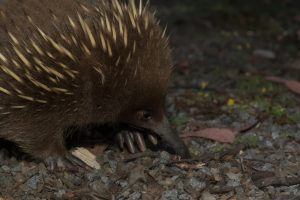
A short-beaked echidna (Tachyglossus aculeatus)
The next day, we left Hobart at 1PM. Passing the Steppes State Reserve, we saw the Tassie trip’s inaugural mammal: a Tasmanian short-beaked echidna (Tachyglossus aculeatus setosus) crossing the road. We ended up seeing quite a lot of these over the trip.
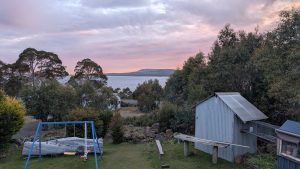
The view from our cabin
After settling into the cabin at Doctors point, we went on an evening walk at a nearby stream, hoping to see a platypus. Instead we saw a rakali (Hydromys chrysogaster) swimming up and down the steam. After sundown, we saw our first Bennetts wallabies (Notamacropus rufogriseus) and rufous-bellied pademelons (Thylogale billardierii). A couple of us went on a further walk around our cabin, where we saw more pademelons, and an eastern bettong (Bettongia gaimardi).
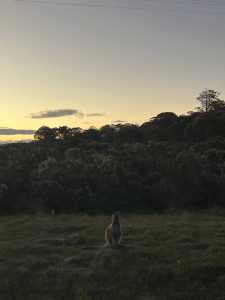
A Bennett’s wallaby (Macropus rufogriseus) ignoring the glorious sunset behind it
Tasmania – December 22: Liffey falls by day, platypus by evening.
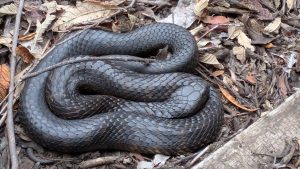
A Tasmanian tiger snake (Notechis scutatus/ater)
The next day we explored the Liffey Falls State Reserve. On the drive down we saw three more echidnas, along with some more wallabies, but the actual walk was light on mammals. Just above the falls, we spotted a very large and sleepy Tasmanian tiger snake (Notechis ater/scutatus), which slithered off after we got a picture.
Later that evening we drove to Deloraine, which I had theorized would be a good platypus watching spot thanks to a clump of iNat sightings there. This was a lucky guess as we got a fantastic view of a massive, and very habituated platypus (Ornithorhynchus anatinus) within minutes of looking. We also briefly saw a second rakali. While there, we learned that somebody in town runs free local platypus walks most evenings from the Empire Hotel, so if you’re keen on seeing them, Deloraine is the place to go.
On the drive back up, we spotted more wallabies, brush-tailed possums, pademelons, and echidnas.
Tasmania – December 23: Sleepy day and mystery scat.
The 23rd was spent mostly relaxing by the great lake, and exploring the area. We went on a short hike up the projection bluff track, and on our way back down, I spotted an interesting looking scat that I was never able to identify. My best guess was a quoll, but if anyone knows for certain, let me know.

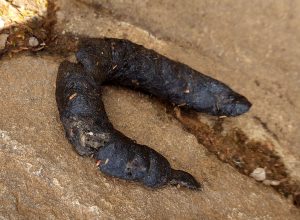
Mystery scat
We spotted many more echidnas during our drives back and forth, including a very young one.
Tasmania – December 24: Christmas eve at Freycinet.
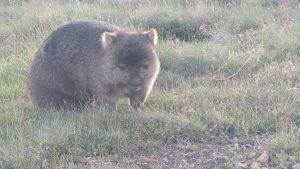
A Tasmanian wombat (Vombatus ursinus tasmaniensis)
We left early in the morning this day for a 3-hour drive to Freycinet National Park. On the way we saw more pademelons and wallabies, but nothing else. We spent most of our time at Freycinet sitting by the Honeymoon Bay beach. I went on a quick snorkel and spotted what I think was a Maori octopus (Macroctopus maorum) although it was deep in a rock crevice and I didn’t get a great look. On the evening drive on our way home we had a bumper crop of mammals, spotting many wallabies and pademelons, along with two Tasmanian wombats (Vombatus ursinus tasmaniensis). We also had an amazing Christmas eve meal at the Great Lake Hotel, so if you’re anything like my father and enjoy food a little too much, that’s the place to be.
Tasmania – December 25: Fantastic Christmas present
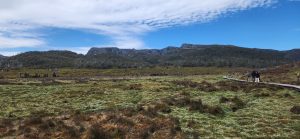
The overland track walkway, where wombats can easily be seen.
Early on Christmas day, we drove to Cradle Mountain National Park hoping that at least on Christmas it wouldn’t be crowded. We were absolutely wrong about this, but luckily the crowds dissipated as we got into the park. Cradle mountain is known for its wombats, and we spotted five on a 15 minute walk on the overland track. The rest of cradle mountain was light on mammals, but one of Tasmania’s giant stoneflies (Eusthenia genus, possibly E. spectabilis) landed on my neck, much to my excitement.
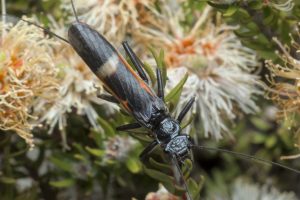
Back at the great plateau, after a Christmas BBQ dinner by the great lake, we went on a spotlighting drive back down to Liffey Falls. On the drive there, we saw a brown eastern quoll (Dasyurus viverrinus), a tawny frogmouth (Podargus strigoides), and many more wallabies, pademelons, and possums. We made a wrong turn on the way to the falls and ended up on a different dirt track, but it was a lucky mistake as we were greeted by an eastern barred bandicoot (Perameles gunnii) right as we were about to turn around. Driving down the actual Liffey Falls track, we received a very late Christmas present: a small Tasmanian devil (Sarcophilus harrisii) ran onto the road in front of us and panicked. I don’t know what it is about Australian mammals, but they have a tendency to forget they can just leave the road the way they entered, instead opting to sprint down the road as fast as their tiny legs can carry them. It’s great for us mammalwatchers, but not so great for their hearts. We followed it for a couple of minutes before we decided to stop the car to let it catch its breath and get off the road.
On the walking section of the Liffey Falls trail we didn’t see any more mammals, but there were plenty of invertebrates, including a bizarre “aerial mating” ritual from a pair of introduced leopard slugs (Limax maximus). The drive back up included more pademelons, bettongs, wallabies, possums, and a tiger quoll (Dasyurus maculatus). Not bad for a day’s work.
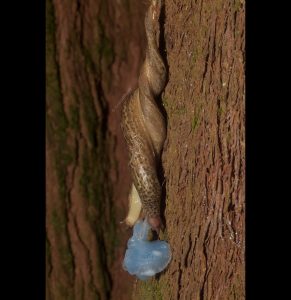
Two leopard slugs (Limax maximus) going at it in the weirdest way possible
Victoria – December 27-28 – The final missing piece
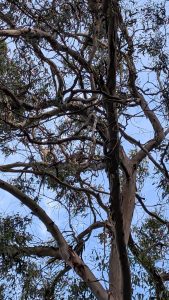
A koala (Phascolarctos cinereus)
The final bit of mammalwatching we did on our holiday was our hunt for the final “classic” Australian mammal – the koala. It just so happens that koalas are abundant in the Otways, A place we were going to pass through anyway as part of the famous Great Ocean Road drive. We decided to try our luck at the Kenett River koala walk, a famous and very touristy spot supposedly thronging with koalas. As with most touristy mammal spots, it was a massive disappointment. We discovered when we arrived that most of the koala colony had left after many tourists threw rocks at them, and also discovered that like many parts of the otways, the walk included an alarming quantity of leeches (much to the pleasure of my sister, who is known for her love of leeches and ants). Luckily, we did manage to find a single koala (Phascolarctos cinereus) Although it was difficult to observe and high in a tree. If you’re keen on seeing a koala in Victoria, you’re better off going to French Island.
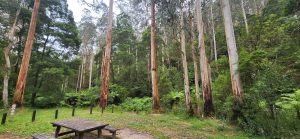
A good spot for a campsite
We stayed the night at Lake Elizabeth Campground near Forrest. This campground is a gorgeous temperate rainforest site that I highly recommend, if you can secure a spot. That night, we heard frequent koala bellowing from almost every direction, and awoke to a near-deafening dawn chorus. Since the chorus was preventing me from having a lie in, I went on a quick hike to lake Elizabeth, expecting to not see much. Instead, I saw more tiger snakes (this time the colourful, mainland variety) on the path, and two platypus in the lake itself.
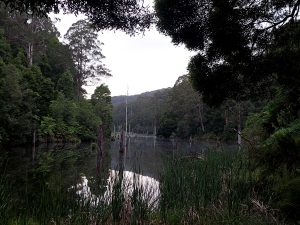
Lake Elizabeth by morning
Final (mammal) species list:
grey-headed flying fox Pteropus poliocephalus
common brushtail possum Trichosurus vulpecula
common ringtail possum Pseudocheirus peregrinus
short-beaked echidna Tachyglossus aculeatus
rakali Hydromys chrysogaster
Bennetts (red-necked) wallaby Notamacropus rufogriseus
rufous-bellied pademelon Thylogale billardierii
eastern bettong Bettongia gaimardi
platypus Ornithorhynchus anatinus
common wombat Vombatus ursinus
eastern quoll Dasyurus viverrinus
eastern barred bandicoot Perameles gunnii
Tasmanian devil Sarcophilus harrisii
tiger quoll Dasyurus maculatus
koala Phascolarctos cinereus
Post author
3 Comments
Leave a Reply
You must be logged in to post a comment.

Jon Hall
Envious of your tiger quoll and even more envious of the always amusing entertainment that comes whenever Katy is near leaches. Nice report P – 😌